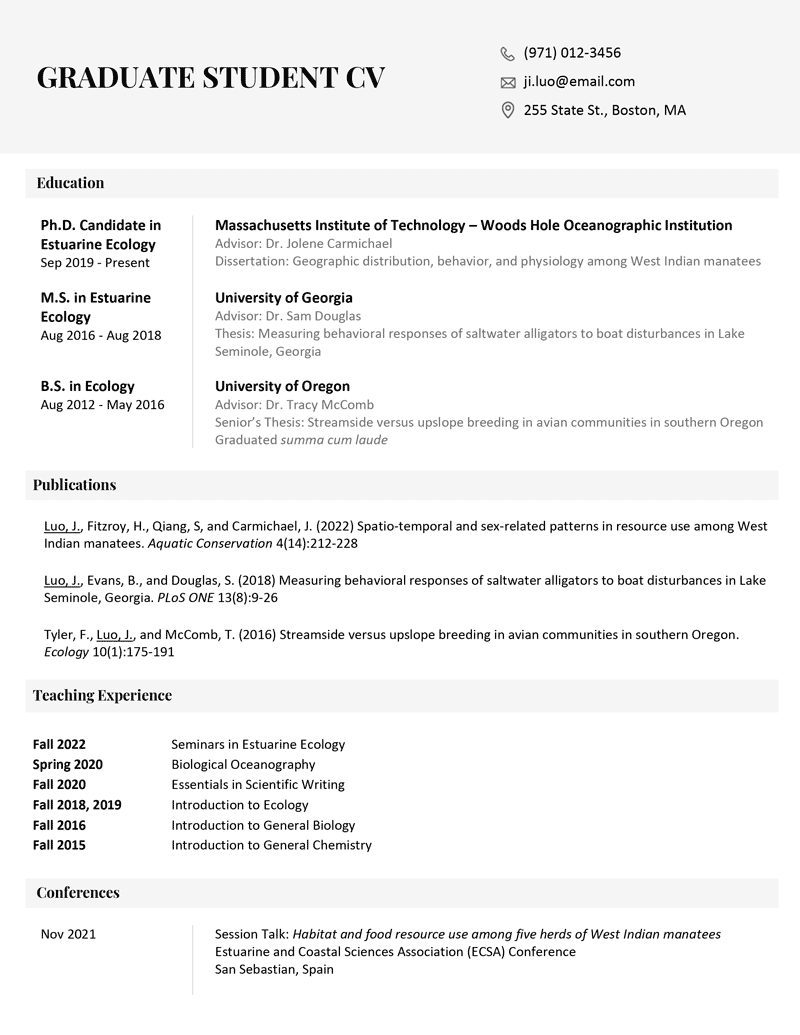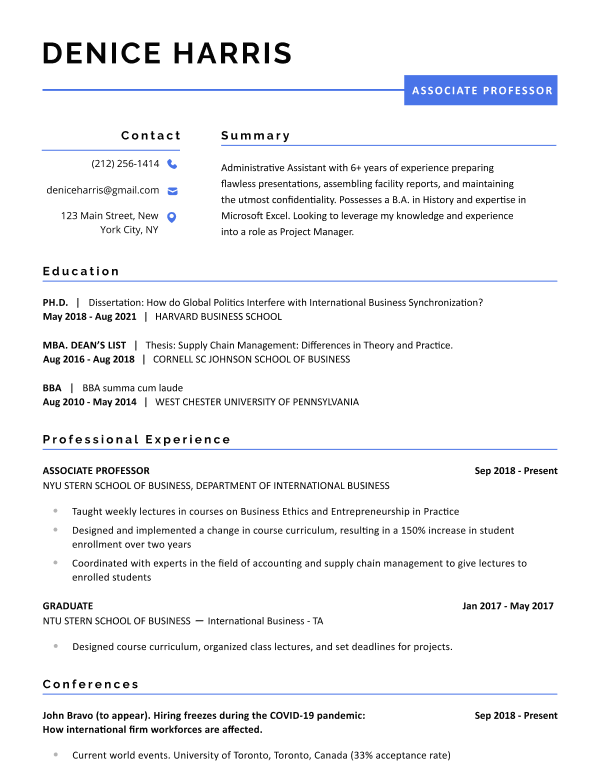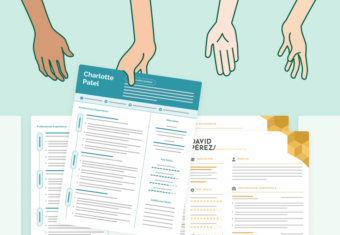What is a CV? In an academic context, the differences between a CV and a resume are substantial, with CVs highlighting your whole academic career, including publications, grants, and fellowships.
Regardless of your seniority, writing an academic CV doesn’t have to be difficult. Our expert guide and CV template will teach you how to put together a competitive CV that helps you land your next position.
Table of Contents
Our free-to-use cv builder can make you a cv in as little as 5 minutes. Just pick the template you want, and our software will format everything for you.
Academic CV examples
Not sure what your CV should look like? Here are two academic CV examples that illustrate how you should format your CV and what information you need to include:
PhD CV example
Here’s an example of the first page of a successful academic CV written by a recent MBA graduate applying for a PhD program.

Graduate student CV example
Here’s an example of the first page of a graduate student CV written in application for a grant fellowship.

What to include in an academic CV
Looking for guidance on what to include on your academic CV? We’ve also compiled a list of essential sections to include in your academic CV:
1. Contact information
Your contact information should be the first thing any department head sees on your CV.
Include the following basic information:
- Name
- Phone number
- Address
However, make sure that you use a professional email address (i.e. FirstnameLastname@email.com) on your CV.
While optional, it’s also common for academics to include other contact information, such as your:
- Google Scholar Profile, ORCID, and/or NCBI Bibliography
- link to a professional website or Github
2. Personal profile
Knowing how to start a resume is critical for landing a job, and your CV is no different when it comes to getting a position in academia.
If you’re applying for research internships or scholarships while still an undergraduate, use the personal profile section at the top of your CV to briefly express who you are, why you want to advance your study in that specific area, and summarize some of your key accomplishments.
But if you already have or are in the process of getting your advanced degree, skip the personal profile. Your education, published works, and employment appointments will speak toward your abilities and potential.
Additionally, your research and/or teaching statements for professorship applications (or biosketch for grant applications) will be the place to show the review committee who you are.
Not sure how long your CV should be? Academic CVs can be much longer than standard resume length (and can extend into tens of pages). To help reviewers find information and keep your application materials together, include your name and page number on every page.
3. Education history
Having a detailed education section on your CV is essential for anyone in academia.
You should state your educational background in reverse chronological order, starting with the university you currently attend (or most recently graduated from). For each entry, state the institutions you’ve attended, degree earned, and your date of graduation.
If you’re writing an undergraduate CV and don’t have much experience yet, highlight achievements in your education section such as your GPA, whether or not you made the Dean’s list, and relevant coursework.
Graduate students and post doctoral researchers should include the name of their thesis advisor and dissertation title (or area of study, if you’re still completing your thesis).
Here’s an example of a properly formatted education section for an academic CV:

4. Professional appointments
List your professional appointments on your academic CV. Keep in mind that these are positions related to academia, not previous jobs you had as a chef or computer programmer.
Only include contractual academic-related work in your professional appointments section, and list the following information for each entry:
- Institution
- Department
- Your title
- Dates employed
- Duties
5. Teaching Experience
If you’re a current or aspiring professor, this section will be one of the most important parts of your CV. List any TA positions, adjunct positions, or courses that you’ve taught here.
For each entry, include the institution, department, course, dates taught, and whether the course was graduate or undergraduate.
There is no need to list your duties as TA. The only exception to this rule is if your department/institution required TAs to design and teach courses. If this is the case for the courses you taught, then list duties on your CV.
Note that if you’ve had a lot of TA/adjunct positions you should only highlight a few that are relevant to the program, position, or field you’re applying for.
6. Publications
Have you conducted and published research? Your publications are possibly even more important than which universities you’ve attended or your professional appointments. This is especially true if you’re already an established expert in your field.
Research contributions and publications are often the cornerstone of an academic CV, especially for positions that are research-intensive. In many disciplines, a strong publication record is a clear indicator of an individual’s ability to conduct independent research, collaborate, and contribute to the field. However, it’s crucial to note that the significance of these contributions varies depending on the nature of the academic role, the department, and the institution.
Dr. Andrew Stapleton of Academia Insider
You should divide your publications into “peer-reviewed” and “other”, and then organize them by publication date.
Furthermore, divide them among where they were published, whether that’s peer-reviewed journals, books, book chapters, book reviews, edited volumes, or web-based publications.
Future publications or those currently under review may also be listed here. Just make sure you provide the full citation or as much information as you currently have. If they are currently in the process of being published they should be categorized as “in press” instead of the year published.
Because most fields determine authorship order by contribution, bold or underline your name for each of your publications to emphasize what you’ve done.
Add an addendum before listing your publications if your field, like mathematics or theoretical computer science, orders authors alphabetically.
Make sure to cite your publications correctly, using your target institution’s preferred citation format consistently throughout your academic CV.
Here’s an example of a properly formatted publications section on an academic CV:

7. Grants & Fellowships
In general, getting funded means that other agencies believe in the potential and worth of your research — and view you to be uniquely equipped to perform future research. So, providing evidence of your grants is a great way to illustrate your accomplishments to department heads.
When listing grants or fellowships on your CV, simply list which institution provided the funding, along with the year span.
Providing the monetary value of the grant is field-specific, so check first before you include it.
8. Awards & Honors
If you’ve received any awards, mention them here. First list the date you received it, granting institution, and the award name (or some sort of description).
Listing the monetary value of the award is field-specific. Check with a trusted official/senior advisor in your field.
9. Invited Talks
If you’ve been invited to speak at conferences or other universities, you should list that in an independent section. Include the institution’s name and location, department, dates of the talk, and a brief description (or simply the title) of what you spoke about. For conferences, you may also want to note the presentation type, such as a plenary or session talk.
Being invited as a speaker is a great addition to your CV because it demonstrates to department heads that you have recognition as an expert in your field of study.
10. Conferences
Have you participated in a conference before? You should include that in your academic CV as well.
Note that these are conferences in which you did not give a lecture. List these with the conference name, organizing panel/institution, and dates.
Additionally, mention the acceptance rate of the conference if you want to emphasize how prestigious the event is.
11. Research experience
If you’re writing an academic CV as an undergraduate, you will want to describe any RA (Research Assistant, Research Associate) experiences you’ve had.
When listing research experience on your academic CV, include the date, institution, and position held.
Then provide a short description, using either paragraph or bullet formatting, to explain how the research was done. Briefly, you should identify the research question and the methodologies you used (e.g., experiments, modeling, literature search).
12. Other optional sections
You may add extra sections to give review committees a full picture of you. Such sections may include:
- languages (along with your proficiency level in reading, writing, and speaking for each)
- professional memberships
- professional service (e.g., students you’ve mentored, journals or funding bodies you review for, public outreach you’ve done)
13. References
Unlike a standard resume or a CV for a job, you should include a list of references toward the bottom of your academic CV.
List each reference’s name, title, mailing address, telephone number, and email address.
While this seems like a lot of information for one person (and it’s highly unlikely that the institution will actually contact them by mail), this is the traditional format for including references on a CV and should be followed by everyone.

2 tips for writing an academic CV that stands out
Now that we’ve gone through the sections that you should include on your academic CV, here are two tips for writing a CV that increases your likelihood of landing your desired position.
1. Know your audience
One of the most overlooked parts of writing a CV is tailoring it for the audience that’ll be reading it. For example, you should adjust your CV to whichever department or field that you’re applying for.
What do they value above anything else? Research? Educational experience? Publications? Whichever it is, list it first on your CV so that the department head finds what they’re looking for immediately.
Additionally, do research online regarding previous applicants and their experience, or talk to experts/senior advisors within your field to find out more about what that institution is looking for in a candidate.
Understand the department’s needs: Research the department’s specialties, gaps, and future directions. Tailor your CV to highlight experiences and skills that align with these.
Emphasize fit: Instead of just listing accomplishments, make it clear how these accomplishments make you a good fit for the department’s culture, mission, and objectives.
Speak their language: Use terminology and keywords that are commonly used in publications or communications from the department you are applying to.Dr. Andrew Stapleton of Academia Insider
2. Don’t use a lot of technical jargon
Your CV should be clear, consistent, and easily understood by anyone that reads it, not just fellow academics in your field.
That’s because university admissions departments, grant reviewers, and hiring committees may not understand all the technical jargon from the field you’re familiar with when reviewing your application. Not only that, but even other academics in your field may not always be familiar with the exact methodologies you’ve used in the past.
Your publications and research will speak for itself when it comes time for department heads to read your CV. For everything else, your information should be as easy to read and understand as possible.
Academic CV template
Here’s an academic CV template that you can paste into Microsoft Word or Google Docs and fill out. It includes an outline for each section you should include, and what information you should list to best highlight your qualifications.
1. CV Heading
FIRST AND LAST NAME
Email: youremail@gmail.com | Phone: 895 555 555 | Address: 4397 Aaron Smith Drive Harrisburg, PA 17101 | Linkedin: linkedin.com/in/yourprofile
2. Personal Profile
Recent graduate from [Institution Name] with expertise in [field]. [Briefly describe any personal achievements, such as Dean’s list, previous research assistant positions held, etc]. Looking to utilize knowledge gained during my research on [research topic] to undertake postgraduate research into [future research topic, or thesis proposal].
3. Education
Dates (most recent first) | Degree Name/Major
Institution/University, Location
Relevant coursework: You can list relevant areas of study here
Honors (if applicable)
4. Professional Appointments
Dates (most recent first) | Position (i.e., Associate Professor, etc.)
Institution/University, Department
- Include a bulleted list of your duties
- Highlight any improvements or accomplishments you made
5. Teaching Experience
Dates (most recent first) | Position (i.e., TA, etc.)
Institution/University, Department
- Further divide by undergraduate and graduate courses taught
- Only include a bulleted list of duties if your institution requires TA’s to solely design and teach courses
6. Research Experience
Dates (most recent first) | Position (i.e., Research Assistant, etc.)
Institution/University
- Include a brief description of your duties. These can be bulleted or in paragraph format
7. Publications
- This section depends on which bibliography you are using
- Below is an example of MLA format
- Note that you can list multiple names, using a comma to separate each name
Last Name, First Initial. “Article.” Journal name Volume Number. Issue Number (Year Published): Pages
8. Awards & Honors
Date | Awarding Institution | Award title
9. References
- List your reference’s first and last name
- Include their address
- Phone Number
Once you’ve mastered the academic CV, find your next academic position using our list of the best job boards for higher education.
Click to rate this article
4.4 Average rating


















